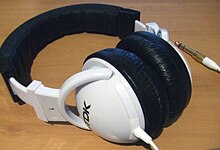Noise-cancelling headphones: Difference between revisions
No edit summary |
queasy |
||
| Line 19: | Line 19: | ||
[[Image:TDK ST-200.jpg|thumb|right|Circumaural headphones enclose the wearer's ear completely. This provides passive noise isolation so that electronic noise cancellation circuitry can perform better.]] |
[[Image:TDK ST-200.jpg|thumb|right|Circumaural headphones enclose the wearer's ear completely. This provides passive noise isolation so that electronic noise cancellation circuitry can perform better.]] |
||
Noise-cancelling headphones have several limitations (that vary from vendor to vendor): |
Noise-cancelling headphones have several limitations (that vary from vendor to vendor): |
||
*They make some individuals queasy<ref>{{cite news|url=http://online.wsj.com/article/SB120277331164160573.html|newspaper=Wall Street Journal}}</ref> . |
|||
*They consume power, usually supplied by a USB port or a [[Battery (electricity)|battery]] that must occasionally be replaced or [[rechargeable battery|recharged]]. Without power the headsets function like a regular headset, without active noise cancellation, or do not function at all. |
*They consume power, usually supplied by a USB port or a [[Battery (electricity)|battery]] that must occasionally be replaced or [[rechargeable battery|recharged]]. Without power the headsets function like a regular headset, without active noise cancellation, or do not function at all. |
||
*They may introduce additional noise, usually in the form of high-frequency hiss. |
*They may introduce additional noise, usually in the form of high-frequency hiss. |
||
| Line 24: | Line 25: | ||
*Early models were generally bulkier than traditional headphones. However, newer models tend to incorporate the batteries in pre-existing space. While this usually reduces the bulk, it does not reduce the extra weight of noise-cancelling headphones compared to traditional headphones. |
*Early models were generally bulkier than traditional headphones. However, newer models tend to incorporate the batteries in pre-existing space. While this usually reduces the bulk, it does not reduce the extra weight of noise-cancelling headphones compared to traditional headphones. |
||
*They are also more expensive than regular headphones |
*They are also more expensive than regular headphones |
||
== See also == |
== See also == |
||
*[[Active vibration control]] |
*[[Active vibration control]] |
||
Revision as of 15:06, 17 June 2013

Noise-cancelling headphones are headphones that reduce unwanted ambient sounds (i.e., acoustic noise) by means of active noise control (ANC). This involves using one or more microphones placed near the ear, and electronic circuitry which uses the microphone signal to generate an "antinoise" signal. When the antinoise signal is produced by the speaker driver in the headphone, destructive interference cancels out the ambient noise as heard within the enclosed volume of the headphone. They should not be confused with noise isolating headphones.
Noise cancellation makes it possible to enjoy music without raising the volume excessively. It can also help a passenger sleep in a noisy vehicle such as an airliner. Research examining the benefits of noise cancelling headphones in the aviation environment has found that compared to passive noise attenuating headphones or no headphones, noise cancelling headphones significantly increases the signal to noise ratio, making hearing important information such as safety announcements easier. [1] The benefits of noise cancelling headphones also extend to situations involving concurrent task (dual task) performance, particularly mind-games (such as Sudoku) as well as listening tasks. [2]
Noise-cancelling headphones typically use ANC to cancel the lower-frequency portions of the noise; they depend on more traditional methods such as soundproofing to prevent higher-frequency noise from reaching the ear. This approach is preferred because it reduces the demand for complicated electronic circuitry that would be required for noise cancellation at higher frequencies, where active cancellation is less effective.[3] To truly cancel high frequency components (coming at the ear from all directions), the sensor and emitter for the cancelling waveform would have to be adjacent to the user's eardrum, which is not currently technically feasible.
History
By the 1950s, systems were created to cancel the noise in helicopter and airplane cockpits. Noise-cancelling aviation headsets are now commonly available.
Currently, most noise-cancelling headsets use analog technology. This is in contrast to other forms of active noise and vibration control in which digital processing is the standard method.
A number of airlines provide noise-cancelling headphones in their business and first class cabins. Noise cancelling is particularly effective against airplane engine noise. In these cases, the headphones are about the same size as normal headphones. The electronics, located in the plane handrest, take the sound from the microphone behind the headphone, invert it, and add it back into the audio signal, which reduces background noise, resulting in a more enjoyable audio experience.
Limitations

Noise-cancelling headphones have several limitations (that vary from vendor to vendor):
- They make some individuals queasy[4] .
- They consume power, usually supplied by a USB port or a battery that must occasionally be replaced or recharged. Without power the headsets function like a regular headset, without active noise cancellation, or do not function at all.
- They may introduce additional noise, usually in the form of high-frequency hiss.
- The noise-cancelling circuitry required for them to operate inherently reduces audio quality.
- Early models were generally bulkier than traditional headphones. However, newer models tend to incorporate the batteries in pre-existing space. While this usually reduces the bulk, it does not reduce the extra weight of noise-cancelling headphones compared to traditional headphones.
- They are also more expensive than regular headphones
See also
- Active vibration control
- Noise-canceling microphone
- Passive noise-cancelling headphones
- Throat microphone
References
- ^ Molesworth, Brett (2013). "Improving intelligibility at a safety critical point". Safety Science. 51. Elsevier: 11–16.
{{cite journal}}: Unknown parameter|coauthors=ignored (|author=suggested) (help) - ^ Molesworth, Brett (2013). "The use of noise cancelling headphones to improve concurrent task performance in a noisy environment". Applied Acoustics. 74. Elsevier: 110–115.
{{cite journal}}: Unknown parameter|coauthors=ignored (|author=suggested) (help) - ^ Reinhard Lerch, Gerhard Sessler, Dietrich Wolf: Technische Akustik: Grundlagen und Anwendungen, Kapitel 14.7.3 Kopfhörer - Hörertypen, Verlag Springer (2008), ISBN 9783540234302, Seite 431
- ^ Wall Street Journal http://online.wsj.com/article/SB120277331164160573.html.
{{cite news}}: Missing or empty|title=(help)
